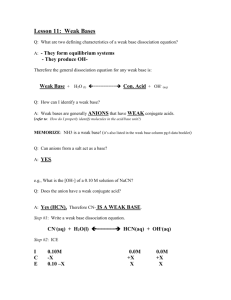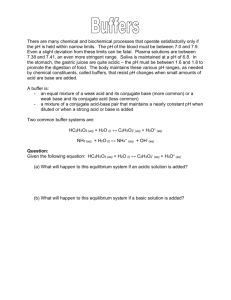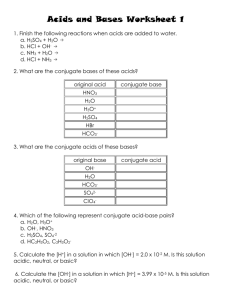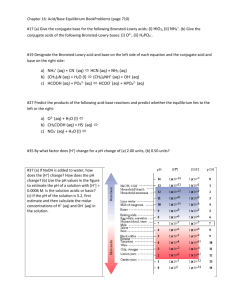Acids and Bases: Kw, pH Calculations, Strong & Weak Acids
advertisement
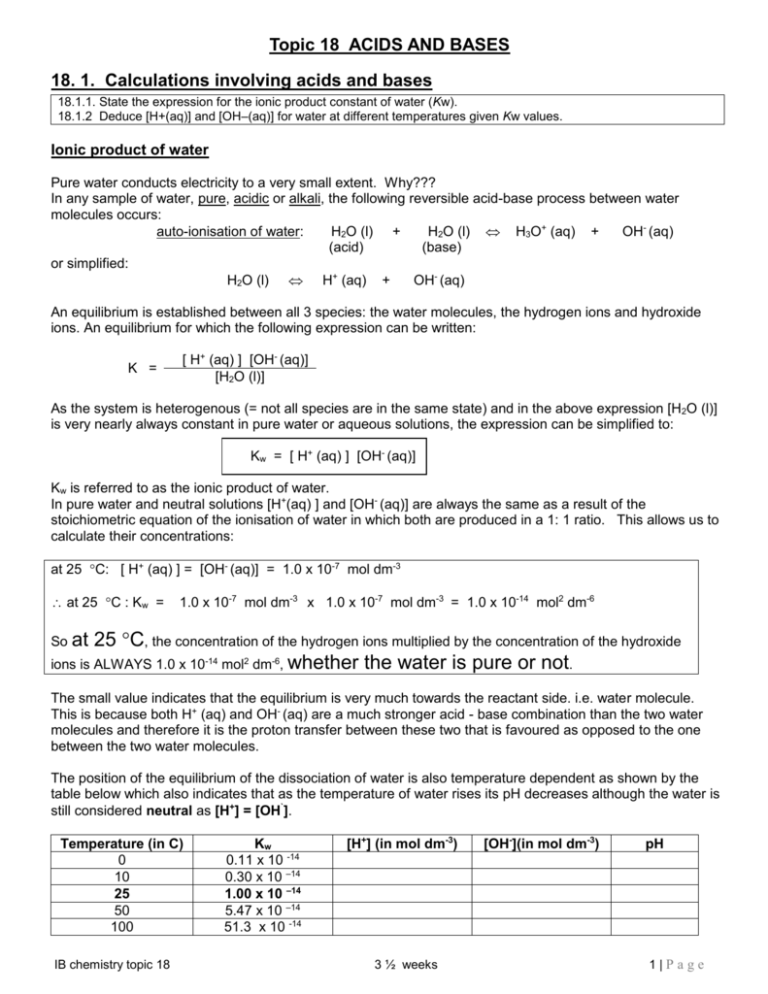
Topic 18 ACIDS AND BASES 18. 1. Calculations involving acids and bases 18.1.1. State the expression for the ionic product constant of water (Kw). 18.1.2 Deduce [H+(aq)] and [OH–(aq)] for water at different temperatures given Kw values. Ionic product of water Pure water conducts electricity to a very small extent. Why??? In any sample of water, pure, acidic or alkali, the following reversible acid-base process between water molecules occurs: auto-ionisation of water: H2O (l) + H2O (l) H3O+ (aq) + OH- (aq) (acid) (base) or simplified: H2O (l) H+ (aq) + OH- (aq) An equilibrium is established between all 3 species: the water molecules, the hydrogen ions and hydroxide ions. An equilibrium for which the following expression can be written: K = [ H+ (aq) ] [OH- (aq)] [H2O (l)] As the system is heterogenous (= not all species are in the same state) and in the above expression [H2O (l)] is very nearly always constant in pure water or aqueous solutions, the expression can be simplified to: Kw = [ H+ (aq) ] [OH- (aq)] Kw is referred to as the ionic product of water. In pure water and neutral solutions [H+(aq) ] and [OH- (aq)] are always the same as a result of the stoichiometric equation of the ionisation of water in which both are produced in a 1: 1 ratio. This allows us to calculate their concentrations: at 25 C: [ H+ (aq) ] = [OH- (aq)] = 1.0 x 10-7 mol dm-3 at 25 C : Kw = 1.0 x 10-7 mol dm-3 x 1.0 x 10-7 mol dm-3 = 1.0 x 10-14 mol2 dm-6 25 C, the concentration of the hydrogen ions multiplied by the concentration of the hydroxide ions is ALWAYS 1.0 x 10-14 mol2 dm-6, whether the water is pure or not. So at The small value indicates that the equilibrium is very much towards the reactant side. i.e. water molecule. This is because both H+ (aq) and OH- (aq) are a much stronger acid - base combination than the two water molecules and therefore it is the proton transfer between these two that is favoured as opposed to the one between the two water molecules. The position of the equilibrium of the dissociation of water is also temperature dependent as shown by the table below which also indicates that as the temperature of water rises its pH decreases although the water is still considered neutral as [H+] = [OH`]. Temperature (in C) 0 10 25 50 100 IB chemistry topic 18 Kw 0.11 x 10 -14 0.30 x 10 –14 1.00 x 10 –14 5.47 x 10 –14 51.3 x 10 -14 [H+] (in mol dm-3) 3 ½ weeks [OH-](in mol dm-3) pH 1|Page It is this acid-base ionization equilibrium in water which dictates the behaviour of acids and bases in terms of [H+ (aq)] and [OH- (aq)]; it allows us to explain why the pH is lower than 7 for acids and greater than 7 for bases. The effect of the addition of any acid or base to water can always be explained using Le Chatelier’s Principle. pH As the concentration values of hydrogen and hydroxide ions are usually very small and not easy to work with, new quantities, the p-notations, were developed: pKw = - log (Kw) (pH = the negative log of the hydrogen ion concentration in solution the negative log is taken so that a positive value is obtained) pKw = - log (1.0 x 10-14) = 14 when converting the whole ionic product expression into p-notation the following relationship is obtained Kw = [ H+ ] [OH- ] - log (Kw) 14 pKw = 14 = - log ([ H+ ] [OH- ] ) = - log ([ H+ ]) + (-log [OH- ]) (- log Kw= pKw); pH = - log ([ H+ ]); pOH = (-log [OH- ])) = pH + pOH When an acid or alkali is added to pure water, Kw remains constant (provided the temperature remains the same) as like any equilibrium constant Kw is independent of initial amounts or concentrations. In any aqueous solution the relationship Kw = [ H+ (aq) ] [OH- (aq)] is always obeyed, regardless of any other equilibria (e.g. ionization of a weak acid or base) in the solution. The equilibrium of the ionization of water responds according to Le Chatelier’s principle upon the addition of an acid or an alkali. As a result the addition of an acid or alkali or any other substance which reacts with either H+ or OH- must results in a change in [ H+ ] and [OH- ] in order to maintain Kw = 1.0 x 10-14 mol2 dm-6. The addition of an acid or alkali has also an effect on the ionisation of water as the addition of an acid or alkali increases either [H+ ] or [OH- ] (increase in product of the equilibrium law) which causes the equilibrium of the reaction below to shift towards the left/reactant side meaning that less water is dissociated in aqueous solutions than in pure water. H2O (l) H+ (aq) + OH- (aq) Also note that pure water becomes acidic at higher temperatures as the Kw increases and therefore the hydrogen ion concentration. Increase in temperature favours ionisation as it is an endothermic process. Calculations of pH and pOH in strong Bronsted acids and bases 18. 1.3 Solve problems involving [H+(aq)], [OH–(aq)], pH and pOH. Strong acids and bases ionise or dissociate (virtually) completely; when they either react or dissolve in water we do not write it as an equilibrium. HCl (l) (acid) + H2O (l) (base) H3O+ (aq) (conj acid) + Cl- (aq) (conj base) In this example, there is competition between the 2 bases, H2O and Cl-, of which water is the strongest and has the greatest tendency to attract protons, a greater Kb. Of the 2 acids HCl is the strongest. IB chemistry topic 18 3 ½ weeks 2|Page The protons transfer between the strongest acid-base combination is favoured which is why the equilibrium is more towards the product. The greater the difference between the acid-base combinations the more the equilibrium is towards one side. When a strong acid is added the amount of H+ that is in the solution is assumed to come entirely from the ionised acid as the ionisation of the water contributes a negligible amount (remember that the ionization of water decreases when an acid or base are added); The same applies to the addition of a strong base. Because of this the concentration of H+ or OH- in strong acidic or alkali solutions or pH or pOH can be calculated from the concentration of the acid or base. However, the [ H+ ] or [OH- ] of the water should not be ignored if the acid or base is greatly diluted as shown by the example in the box below. So: pH = - log [H+] pOH = - log [OH-] For strong monoprotic acids and monobasic bases: [acid] = [H+] and [base] = [OH-] Exercises involving strong acids and bases 1. Calculate the pH of a HNO3 solution whose hydrogen ion concentration is 0.76 mol dm-3. 2. Calculate the pH of (a) a 1.0 x 10-3 mol dm-3 HCl solution and (b) a 0.020 mol dm-3 Ba(OH)2 solution. 3. What is the pH of a 5.0 x 10-4 mol dm-3 solution of NaOH at 25 °C? 4. What is the pH of a 0.0020 mol dm-3 solution of HCl? 5. The OH- concentration of a certain ammonia solution is 0.88 mol dm-3. What is the pH of the solution? 6. The pH of rainwater in a certain region of Europe on a particular day was 4.82. Calculate [H+]. 7. Calculate the [H+] and pH in pure water at a temperature of 100 °C when Kw is 51.3 x 10-14. For most such calculations the hydrogen ions produced as a result of the ionization of water are ignored as this concentration is very small compared to the hydrogen concentration from the strong acid. However, ignoring the hydrogen ion concentration in very diluted acid solutions does become an error as shown by the example below. For instance if the 1 x 10-7 [H+ ] from the ionization of water is ignored than a nitric acid solution of a concentration of 1 x 10-8 M would have a pH of 8 instead of 6.96 which is obtained when both concentrations are added. The pH of such a solution would be : pH = -log ( 1 x 10-7 + 1 x 10-8) = - log ( 1.1 x 10-7) = 6.96 It should also be appreciated that strong acids or bases can have pH’s lower than 0 (a negative pH if the concentration is higher than 1) or larger than 14 in the case of bases!!!!! IB chemistry topic 18 3 ½ weeks 3|Page Calculations of pH and pOH in weak acids: Ionization constant/dissociation constant of weak acids and weak bases 18.1.4 State the equation for the reaction of any weak acid or weak base with water, and hence deduce the expressions for Ka and Kb. 18.1.5 Solve problems involving solutions of weak acids and bases using the expressions: Ka × Kb = Kw pKa + pKb = pKw pH + pOH = pKw. 18.1.6. Identify the relative strengths of acids and bases using values of Ka, Kb, pKa and pKb. The pH on its own is not an accurate indicator of the strength of an acid or alkali as the pH of any solution depends on: the strength of the acid/alkali and the concentration of the acid or alkali. A very diluted hydrochloric acid solution can have a high pH! The ionization or dissociation of a weak acid or base IN WATER is another example of an equilibrium process. The extent of the dissociation of the weak acid or base is reflected by the position of the equilibrium in the dissociation process or reaction with water. The equilibrium constant indicates the position of the equilibrium during this dissociation and the value of the equilibrium constant tells how much dissociation has taken place. Within this context, the equilibrium constant is called the dissociation constant or acidity/basicity constant. The dissociation constant is the equilibrium constant for the equilibrium reaction between an acid or base and water at 25 C. The greater the constant, the more the equilibrium is towards the product, the more the acid (base) has dissociated, the stronger the acid (base) is. The dissociation constant remains constant at the same temperature and does not change with acid or base concentration which is why it gives an indication of the strength of an acid or base and allows us to compare acid and base strengths. (Weak acids or bases exist mainly as non-ionised molecules). Acid dissociation/ionization constant Equation showing the ionization in water: HA + (=acid) H2O (=base) H3O+ (aq) + (=conj acid) A- (aq) (=conj base) (reaction of acid with water) (also equation which defines the ionization constant) The derived expression for the acid ionization/acidity constant becomes: Ka = [ H+ (aq) ] [A- (aq)] [ HA] EXAMPLE: In the case of ethanoic acid the ionization equation (reaction with water) and the acid ionization constant expression become (concentrations should be equilibrium concentrations): Ionization of ethanoic acid: CH3COOH (l) acid ionization constant: (ignoring H2O) + Ka = H2O (l) H3O+ (aq) + CH3COO- (aq) [ H+ (aq) ] [CH3COO- (aq)] [CH3COOH (l)] (As before, the [H+(aq) ] contributed by the auto-ionisation of water is ignored as usually it is still relatively small compared to the hydrogen concentration of the acid solution provided its concentration is large enough). IB chemistry topic 18 3 ½ weeks 4|Page Ionization constant values for a variety of acids. acid HClO4 HI HBr HCl H2SO4 HNO3 H3O+ HF CH3COOH H2S HCN H2O CH3OH NH3 Ka in mol dm-3 (at 25 C) very large very large very large very large very large very large very large 6.8 x 10 –4 1.8 x 10 –5 1.0 x 10 –7 7.0 x 10 –4 7.0 x 10 –4 very small very small conjugate base ClO4IBrClHSO4NO3H2O FCH3COOHSCNOHCH3ONH3- pKa small small small small small small small 3.2 4.7 7.0 9.4 14.0 large large Base ionization constant Equation showing reaction with water: B (base) + H2O (acid) BH+ (aq) (conj acid) + OH- (aq) (conj base) The derived expression for the base ionization constant then becomes: Kb = [ B+(aq) ] [OH- (aq)] [B] EXAMPLE: In the case of ethanoic acid the ionization equation (reaction with water) and the acid ionization constant expression become (with all concentration equilibrium concentrations): Ionization of ammonia: NH3 (g) + base ionization constant: (ignoring H2O) H2O (l) Kb = NH4+ (aq) + OH- (aq) [ OH- (aq) ] [NH4+ (aq)] [NH3 (g)] It is important to realise that an equation defining the ionization of a weak acid or base should be an equation involving the weak acid or base AND WATER !!!!! pKa and pKb To make some calculations easier p-notations are used: pKa and pKb are the negative logarithms of Ka and Kb. pKa = - log (Ka) and pKb = - log (Kb) The higher the Ka, the lower the pKa and therefore the stronger the acid. The lower the Ka, the higher the pKa and therefore the weaker the acid. Similarly the lower the Kb, the higher the pKb and therefore the weaker the conjugate base. Exercise Write (i) the equation of the reaction with water and the (ii) ionization constant expression for the following acids and bases: (a) HCOOH (b) HNO3 IB chemistry topic 18 (c) H2S (d) HCN (e) CH3OH 3 ½ weeks (f) CH3NH2 (g) NH3 5|Page Calculations involving pH and concentrations of acid or alkali solutions from Ka/b and vice versa. pH calculation from ionization constant for weak acids and bases The ionization constant allows us to calculate the pH of a weak/base solution provided we also know the initial concentration of the acid. Using the ionization equilibrium expressions and making the assumptions explained below an expression in terms of hydrogen ions can be derived: For a weak acid: Ka = Then: [ H+ (aq) ] [A- (aq)] [ HA] [H+] = K assume that [ H+ (aq) ] = [A- (aq)] [ H+]2 [HA] and pH = -log [H+(aq)] x [acid] a Ka = For a weak base: Kb = Then: [ BH+ (aq) ] [OH- (aq)] [ HA] [OH-] = K b assume that [ OH- (aq) ] = [B- (aq)] Kb = [ OH-]2 [B] and pOH = -log [OH-(aq)] x [base] These above expressions can be used to calculate: pH Ka , Kb the concentration of the acid or base needed to make a solution of a certain pH. Assumptions/approximations made during these calculations !!!!!!!!!: You should always be aware that you have made the following assumptions or approximations. 1. [H+] or ([OH-]) from the auto ionization of water is ignored and is not added to any equilibrium concentration of H+ and OH- in the equilibrium expression and therefore for monoprotic acids and monobases: [ H+ ] = [A- ] (or [OH-] = [BH+]) 2. [HA] (or [B]) at start = [HA] at equilibrium although in reality: [HA]eqm = [HA]eqm but because the acids are weak, and therefore [ H+ ] is very small: [ H+ ] [HA]eqm = [HA]initial The second approximation can only really be done if the acid is very weak (which it is in most cases!) with a Ka or Kb of less than 10-5 . IB chemistry topic 18 3 ½ weeks 6|Page However, if in the question it states how much the acid dissociates or they give us the [H+} ] than we should really use this in our calculations and use an accurate equilibrium concentration instead of the initial. Exercises 1. A 0.0100 mol dm-3 solution of a weak acid has a pH of 5.00. What is the ionization constant of the acid. 2. Benzoic acid has a pKa of 4.2. What is the pH of 0.10 mol dm-3 solution of this acid? 3. What concentration of hydrofluoric acid is required to give a solution of pH 2.00, if the ionization constant of the acid is 6.76 x 10-4 mol dm-3? 4. Calculate the concentration of H+, A- and non-ionised HA in a 0.2 mol dm-3 HA solution. Ka = 2.7 x 10-4. 5. Calculate the pH of a 0.05 mol dm-3 nitrous acid (HNO2 ) solution. Ka = 4.5 x 10-4 . 6. What is the pH of a 0.122 mol dm-3 monoprotic acid whose Ka = 5.7 x 10-4. 7. The pH of a 0.100 mol dm-3 solution of a weak monoprotic acid HA is 2.85. What is the Ka of the acid? 8. The pH of a 0.06 mol dm-3 weak monoprotic acid is 3.44. Calculate K a. 9. What is the pH of a 0.400 mol dm-3 ammonia solution. Kb = 1.8 x 10-5. 10. Calculate the pH of a 0.26 mol dm-3 methylamine solution. Kb = 3.7 x 10- 4. 11. Calculate the percent ionisation of a 0.60 mol dm-3 hydrofluoric acid solution (HF). Ka = 7.1 x 10- 4. 12. Calculate the percent ionisation of a 0.60 mol dm-3 HCN solution and compare its strength with that of HF. Ka = 4.9 x 10- 10. 13. Calculate the percent ionisation of nitrous acid (HNO2) at 0.25 mol dm-3, Ka = 4.5 x 10- 4. Relationship between Ka and Kb for an acid-conjugate base pair (or vice-versa) Sometimes only the Ka of the conjugate acid of a base is given; the Kb of the base can then be calculated as a result of the relationship explained below: Starting from an acid: equilibrium expression to define Ka for the acid. HA (=acid) + H2O H3O+ (aq) + A- (aq) (=conjugate base) [ H+ (aq) ] [A- (aq)] Ka = [ HA] Considering its conjugate base: equilibrium expression for the conjugate base when it reacts with water: A- + H2O HA (aq) + OH- (aq) [HA (aq) ] [OH- (aq)] Kb = [ A- ] IB chemistry topic 18 3 ½ weeks 7|Page When multiplying both expressions for Ka and Kb : [ H+ (aq) ] [A- (aq)] [HA] Ka [HA (aq) ] [OH- (aq)] [ A- ] x x = [ H+ (aq) ] [OH- (aq)] = Kb = Kw pKb = pKw Kw Taking the negative log of each side pKa + Examples of how above relationship can be used: Example 1: The pKa for NH4+ (= acid) = 9.25 so what is the pKb for NH3 ? Equilibrium expression for acid is: NH4+ + (=acid) H2O NH3 (aq) (=conj base) + H2O+(aq) pKa for NH4+ (=conjugate acid) = 9.25 Equilibrium expression for conjugate base: NH3 (aq) + H2O+(aq) NH4+ + H2O pKb = 14 – 9.25 = 4.75 Example 2: the Ka for NH4+ = 5.6 x 10-10 . Calculate Kb for NH3 1.0 x 10-14 Kw Kb = = 1.8 x 10 -5 = Ka 5.6 x 10 -10 Significance of the above relationship Ka x Kb = Kw means that the stronger the acid, the larger its Ka, the weaker its conjugate base must be as a small Kb is needed to keep the same product. So strong acids have the weakest conjugate bases whilst weak acids have stronger conjugate base. Strong bases have weak conjugate acids. Effect of dilution on the ionization of a weak acid. Dilution of a weak acid increases its ionization as the position of its equilibrium shifts towards the product side. Why? The addition of water lowers the concentration of the products as well as the concentration of the reactants. However, the dilution has a greater effect on the product side making the new ratio less than Ka which causes the equilibrium to shift towards the products i.e. more ionisation. IB chemistry topic 18 3 ½ weeks 8|Page 18. 2. Buffer solutions 18.2.1 Describe the composition of a buffer solution and explain its action. 18.2.2 Solve problems involving the composition and pH of a specified buffer system. A buffer is a solution that resists change in pH when a small amount of a strong acid or base is added, provided that the amount is less than that of either component in the buffer. A buffer can be: an acidic buffer = a weak acid + its conjugate base (supplied by a salt of the acid) or an alkali buffer = a weak alkali + its conjugate acid (supplied by a salt from the alkali) Acidic buffer acid: HA H+ + A- ( = conjugate base) salt/conjugate base MA M+ + A- (= conjugate base) (1) Addition of acid to buffer; as a result [H+ ] increases: equilibrium in equation (1) shifts to the left as extra H+ are mopped up by conjugate base supplied by the salt; ionic equation to show shift in equilibrium: A- + H+ HA [H+] is brought back down again to a level near to what it was before the addition of acid; Addition of an alkali to the buffer; [H+ ] decreases as OH- are mopped up by H+: equilibrium in equation (1) shifts to the right and more HA dissociates which is possible as there are many undissociated HA molecules (= weak acid); ionic equation: OH- + H+ H2O [H+] is brought back up close to the level it was before the addition of alkali; In acidic buffer the conjugate base maintains the pH when an acid is added as it combines with extra hydrogen ions. The weak acid (which exists mainly as molecules) itself produces extra hydrogen ions to mop up any hydroxide ions that were added when an alkali is added. The acid needs to be weak so that there are a large number of non-ionised molecules that can act as a supply of hydrogen ions to react with added hydroxide ions. A small reduction does not really much affect the pH which would be the case if a large amount of acid or alkali was added. An acid buffer can also be made by adding a half stoichiometric amount of a strong alkali to a weak acid. IB chemistry topic 18 3 ½ weeks 9|Page Alkali buffer alkali: MOH salt/conjugate acid MA OH- A- + + M+ ( = conjugate acid) (1) M+ (= conjugate acid) Addition of acid to buffer; [OH- ] decreases as H+ react with it equilibrium in equation (1) shifts to the right as extra H+ are mopped up by OH- ; more of the alkali ionises to allow this to happen; ionic equation: OH- + H+ H2O due to the increased ionisation [OH- ] is brought back up to close to the level it was before acid addition; Addition of an alkali so [OH- ] increases; equilibrium in equation (1) shifts to the left; extra OH- are mopped up by conjugate acid M+; ionic equation to show shift in equilibrium: OH- + M+ MOH [OH- ] is brought back down to near the level it was at before the addition of alkali; In an alkali buffer, the conjugate acid maintains the pH when an alkali is added as the conjugate acid combines with the extra hydroxide ions. The alkali itself produces extra hydroxide ions to mop up any hydrogen ions that were added when an acid is added. An alkali buffers can also be made by making a solution of a weak alkali and a strong acid (half the number of moles of the weak alkali; either same volume and half concentration or vice versa). Calculation of pH of an acid buffer An acid buffer consists of the following systems together: acid: HA H+ + A- ( = conjugate base) salt/conjugate base MA M+ + A- (= conjugate base) The equilibrium constant expression for such an acid buffer is [H+] [A- ] [A-] + Ka = or Ka = [H ] x [HA] [HA] Remember that all the above concentrations should be concentrations at equilibrium which are difficult to measure, but we can make the following assumptions: [A-]equilibrium = [salt]initial as the salt is by far the largest supplier of A- [HA]equilibrium = [HA]initial (same assumption as with weak acids) Because of these assumptions the equilibrium expression above can then be rewritten in terms of the initial concentrations which are known: [H+] [salt ]initial Ka = [acid]initial IB chemistry topic 18 3 ½ weeks 10 | P a g e and expressed in terms of hydrogen concentration: [H+] = Ka [acid]initial [salt ]initial x The above expression tells us that the [H+] and therefore the pH of a buffer depends on: Ka of the acid; ratio beween acid and salt concentration. Therefore, the dilution of a buffer solution does not affect its pH as the ratio [salt/acid] itself is not changed by the dilution The above expression can also be rewritten in its log form and then becomes [acid]initial pH = pKa - log [salt ]initial which can also be used to calculate the pH of a buffer solution. Calculation of the pH of an alkali buffer alkali: MOH salt (fully ionised) MA OHA- M+ ( = conjugate acid) + + M+ (= conjugate acid) Equilibrium constant expression for an alkali buffer is Kb = [OH-] [M+ ] [MOH] = [OH-] x [M+] [MOH] Remember that all the above concentrations are concentrations at equilibrium, but we can make the following assumptions: [M+]equilibrium = [salt]initial and [MOH]equilibrium = [MOH]initial Because of these assumptions the equilibrium expression can then be rewritten in terms of the initial concentrations which are known Kb = [OH-] [salt ]initial [base]initial and in terms of hydroxide ion concentration: [OH-] = Kb x [base ]initial [salt]initial e.g. [NH3] e.g. [NH4+] The above expression can also be rewritten in its log form and then becomes [base]initial pOH = pKb - log [salt ]initial which can also be used to calculate the pH of a buffer solution. (Lastly, it is also interesting to note that when a buffer is made, the addition of the salt to the weak acid, causes the equilibrium in the ionization to shift further to the reactant side making our assumption of taking the initial acid concentration as the acid concentration at equilibrium less of an error). Exercises (calculating pH after an acid/alkali has been added is an extension) IB chemistry topic 18 3 ½ weeks 11 | P a g e 1. (a) Calculate the pH of a buffer system containing 1.0 mol dm-3 CH3COOH and 1.0 mol dm-3 CH3COONa. (b) What is the pH of the buffer system after the addition of 0.1 mole of gaseous HCl to 1dm3 of the solution. (no change in volume assumed) 2. (a) Calculate the pH of the 0.3 mol dm-3 NH3 (=NH4OH) and 0.36 mol dm-3 NH4Cl buffer system. (b) What is the pH after the addition of 20.0 cm3 of 0.050 mol dm-3 NaOH to 80.0 cm3 of the buffer solution? 3. (a) Calculate the pH of a solution containing 0.2 mol dm-3 CH3COOH and 0.3 mol dm-3 CH3COONa. (b) What would be the pH of a 0.2 mol dm-3 CH3COOH if no salt were present? 4. A buffer was prepared by mixing exactly 200 cm3 of a 0.6 mol dm-3 NH3 solution and 300 cm3 of 0.3 NH4Cl solution. Kb of NH3 = 1.8 x 10- 5. (a) What is the pH of this buffer, if we assume a final volume of 500 cm3? (b) What will be the pH after 0.02 dm3 of 1 mol dm-3 HCl is added? 18. 3. Salt solutions: hydrolysis of salts (salt = any ionic compound not containing O2- or OH-) 18.4.1 Deduce whether salts form acidic, alkaline or neutral aqueous solutions. Hydrolysis = reaction with water. The dissociation of weak acids and alkalis are hydrolysis reactions. Salts are strong electrolytes and ionise completely in water. When they dissociate i.e. when they dissolve in water to form a salt solution, their positive and negative ions become surrounded by water molecules. This attraction results in a reaction (hydrolysis) between the salt ions and the water molecules as both positive and negative ions act as Bronsted bases or acids and set up acid-base equilibria with the water molecules. If these ions are strong enough acids or bases they can produce enough hydrogen or hydroxide ion to affect the overall balance between hydrogen and hydroxide ions and by doing so change the pH of the salt solutions from 7. Salt hydrolysis is the reason why in some titrations the pH is not 7 at equivalence point. However, if the ions are weak acids or weak bases we can ignore the effect of their reaction with water on the pH of the salt solution as they do not effect the equilibrium of the auto-ionization. Salts that produce neutral solutions (salts from strong acids and bases). Example: NaNO3 (aq) Na+ (aq) + cannot act as a Bronsted acid/base NO3- (aq) very weak conjugate base No significant hydrolysis occurs and therefore [H3 O+] x [OH- ] = 1x 10-14 is not affected so neither is the pH . Salts forming neutral solutions are salts containing: alkali/alkali earth metals; conjugate bases of strong acids. Salts that produce basic solutions (salts from strong alkali metals and weak acids) Example: CH3COONa (aq) Na+ (aq) does not donate H+ + CH3 COO- (aq) stronger conjugate base The ethanoate ion, CH3 COO- , as it is a stronger base than water (larger Kb), it reacts with the hydrogen ion from the water according to the following equation: IB chemistry topic 18 3 ½ weeks 12 | P a g e H2O (Bronsted acid) CH3 COO- (aq) + (Bronsted base) CH3 COOH (aq) OH - (aq) + This increases the concentration of OH - to above 1 x 10-7 depending on the strength of the conjugate base resulting in a solution with a pH greater than 7. The weaker the acid, the stronger the conjugate base, the higher pKb, the greater the pH. Use table 15 in the data booklet to calculate the pKb of the ethanoate ion. Salts that produce acidic solutions (salts from weak bases and strong acids) Example: NH4 Cl (aq) NH4+ (aq) + stronger conjugate acid than water Cl- (aq) (=very weak base) Hydrolysis reaction: NH4+ is a stronger acid than water: NH4 + (aq) + H2O NH3 (aq) + H3O+ (aq) This reaction increases the concentration of H+ to above 1 x 10-7 depending on the strength or Ka of the conjugate acid. Also salts containing ions with high charge densities such Al3+, Fe2+,Fe3+, Cr3+ and Be2+, form acidic solutions. These ions form complexes with water as you already know. Due to their high charge density, they polarise the ligand water molecules even more than the free water molecules. The very positive hydrogens on the outside of the complex are attracted and removed by free water molecules surrounding the complex as shown by the equation below: [Fe(H2O)6]3+ + H2O [Fe(OH)(H2O)5]2+ + H3O+ (aq) This also increases the hydrogen concentration in the solution reducing its pH. Salts from weak acid and weak base Two hydrolysis reactions occur; the pH of the solution depends on the Ka of the conjugate acid and the Kb of the conjugate base. If Ka = Kb then pH = 7 if Ka Kb then pH 7 If Ka Kb then pH 7 18.4 Acid-base titrations 18.4.1. Sketch the general shapes of graphs of pH against volume for titrations involving strong and weak acids and bases, and explain their important features. Simulations: http://chem-ilp.net/labTechniques/AcidBaseIdicatorSimulation.htm http://www.wfu.edu/~ylwong/chem/titrationsimulator/index.html Acid-base titrations are examples of neutralisation reactions. A neutralisation is any reaction between an acid and a base and does not necessarily produce a neutral solution (see salt hydrolysis ) but does produce water and/or carbon dioxide and a temperature rise as neutralisation reactions are exothermic. IB chemistry topic 18 3 ½ weeks 13 | P a g e Titration is a technique used to determine the concentration of an unknown acid or alkali solution but is also used to make salts as salts are a product of the reaction. As acid-base titrations do not produce a coloured product, an indicator needs to be used to indicate when the equivalence point of the titration has been reached as that is the point at which the reaction should be completed. The equivalence point of a titration is the point at which stoichiometric equivalent amounts of both reactants (acid and base) have been added. In an acid-base titration, it is the point at which [H+] = [OH-] in the flask. In the case of a monoprotic acid reacting with a monobasic base, the amounts of each, acid and base, should be equal provided they have the same concentration. In the case of a diprotic acid and monobasic base twice the amount of base is needed to neutralise the acid. For each titration the pH can be measured every time a small amount of alkali is added to the acid and this raw data can then be used to draw a pH curve. In most acid-base titrations the pH-curve shows a steepness near the equivalence point as the pH changes abruptly and over a larger number of points on the pH-scale (remember that one point on the pH scale means a tenfold difference in concentration of hydrogen ions). Below are described the four main types of titrations. In each type the substance mentioned last is the substance that has been added. In practice it is usually the acid which is added into the alkali as the alkali would corrode the burette. It is important to remember in these titrations that all the reactions go to completion according to the stoichiometric equation even if the acid or the base is weak. This means that a weak and a strong monoprotic acid will have the same equivalence point i.e. the same number of moles of alkali needs to be added. In the case of a weak acid, each addition of an alkali moves the equilibrium further towards the products and completion. Strong acid – strong alkali Important features + pH calculations: before equivalence point at equivalence point beyond equivalence point low pH pH = 7 as both conjugate bases and the pH is depended on the the pH depends entirely on the acids are very weak and amount of alkali or OH- that is in [H+] of the acid which has + do not hydrolyse excess. dissociated fully so all H of the acid are already in solution; pH is calculated by taking the natural log the pH changes over a pH levels out at a large value of the difference in the number of very large pH range. moles of [OH-] and [H+] Indicator: any indicator can be used as at equivalence point the pH changes over a very large pH range. Exercise on titrations (strong acid-strong alkali) Complete the following table for the titration of a strong acid with a strong base. exp 1 2 3 4 volume of 0.1 mol dm-3 acid (in cm3) 50.0 50.0 50.0 50.0 IB chemistry topic 18 volume of 0.1 mol dm-3 alkali (in cm3) 25.0 40.0 49.0 49.5 total volume (in cm3) moles of H+ 3 ½ weeks moles of OH- excess ions ( H+ or OH- ) pH 14 | P a g e 5 6 7 50.0 50.0 50.0 49.9 50.1 60.0 Weak acid-strong alkali (eg acetic acid and sodium hydroxide) Important features + pH calculations: before equivalence point pH 0 or 1 pH calculations: use weak acid method at the start when no base has been added the addition of a strong base would suggest a rapid increase in pH; however, the pH increases slowly because of the buffer system created consisting of the weak acid and the salt produced as soon as the base is added (e.g. acetic acid and sodium ethanoate); halfway to equivalence at equivalence point the centre of the buffered region is at the point when half the amount of acid has been neutralised as at that point the ratio of [acid]/[salt] = 1 which is at the Ka of the acid. pKa = pH (this method can be used to identify a weak acid by finding its pKa from a titration curve) pH above 7 acid has been neutralised; the conjugate base of the weak acid is a stronger base than water and hydrolysis occurs increasing the pH at equivalence point; beyond equivalence point steep section of curve is above 7 the pH is depended on the amount of alkali or OH- that is in excess. pH levels out at a large value to calculate pH, the method for weak acidic buffer needs to be used Indicator: its end-point or pH range over which it changes colour or pKind must be greater than 7. Strong acid-weak alkali before equivalence point at equivalence point low pH pH is below 7 the pH depends entirely on the [H+] of the acid which has strong acid has been dissociated fully so all H+ of the neutralised but salt acid are already in solution; pH is hydrolysis occurs ; weak calculated by taking the natural log base has strong conjugate of the difference in the number of acid; moles of [OH-] and [H+] Indicator: needs have its end point/Ka below pH 7. beyond equivalence buffer formed between salt and excess alkali pH calculation: use method for alkali buffer pH curve levels out a pH 9, 10 or 11 18.5.4. Weak acid-weak base before equivalence point pH is 2 or higher pH calculations: use weak acid method at the start when no base has been added the addition of a strong base would IB chemistry topic 18 at equivalence point pH around 7 depending on the strength of the conjugate acid or alkali 3 ½ weeks beyond equivalence buffer formed between salt and excess alkali pH calculation: use 15 | P a g e suggest a rapid increase in pH; however, the pH increases slowly because of the buffer system created consisting of the weak acid and the salt produced as soon as the base is added (e.g. acetic acid and sodium ethanoate);pH calculations: use strong acid method salt hydrolysis occurs (pH less than 7); the pH depends on the Ka of the conjugate acid from the weak base, method for alkali buffer pH curve levels out a pH 9, 10 or 11 no sharp change in pH as both before and after equivalence point a buffer system is set up at equivalence point (near pH = 7) hydrolysis of both conjugate acid and base occurs; pH depends on the difference in strength between the conjugate acids or bases. Some points to consider: as the acids (or bases) get weaker (e.g. pK of more than 5) the pH jump at equivalence point gets smaller and smaller until there is barely any steepening of the titration curve an acid-base titration needs the use of an indicator but for an indicator to be effective and accurate a pH jump of at least two pH points is needed at equivalence point; because of this reason titrations using very weak acids or alkalis are impossible; halfway towards equivalence pH = pK a/b. 18. 5 Indicators 18.6.1 Describe qualitatively the action of an acid–base indicator. 18. 6. 2 State and explain how the pH range of an acid–base indicator relates to its pKa value. 18. 6. 3 Identify an appropriate indicator for a titration, given the equivalence point of the titration and the pH range of the indicator. See http://www.chemguide.co.uk/physical/acidbaseeqia/indicators.html#top In most titrations, we know the equivalence point has been reached when there is a sharp increase in pH. Indicators are used to tell us when there has been such a sharp pH increase. How does an indicator work? The indicators used in acid-base reactions are usually weak acids or weak bases themselves and this is important as it is all about the position of the equilibrium in their dissociation. When they dissociate, their ions have a different colour than the undissociated molecules. An indicator shows the colour of either the ion or of the undissociated molecule if the concentration ratio of both is at least 1:10 or vice versa. if the concentration of one is at least 10 times more than the other one it will then show that colour. The indicator shows the colour of the ion if the ion concentration is at least 10 times the concentration of the undissociated molecules. If the ratio is less or 1 the indicator shows a mixture of both colours which is difficult to judge. During a titration a colour change is achieved when the ratio of [undissociated molecules] : [ions] changes from 10 : 1 to 1 : 10 or vice versa. In a titration this also needs to happen near the equivalence point of the titration. Example: an acidic indicator HIn HIn (colour A) Ka = H+ (aq) + In- (aq) (colour B) [ln- (aq)] [H+ (aq )] [Hln] addition of the indicator to an acid solution, the following occurs: IB chemistry topic 18 3 ½ weeks 16 | P a g e [H+ (aq)] increases; equilibrium shifts to the left and [HIn] increases; the indicator shows predominantly the colour of the nonionised molecule which is colour A. addition of the indicator to an alkali: [H+ (aq )] decreases; equilibrium shifts to the right and [lit-] increases; the indicator shows predominantly the colour of the ionised particle which is colour B. The end point of the indicator (i.e. the point at which one colour becomes more dominant than the other) is reached when the colour is midway between both (in the case of litmus this will be purple); in terms of equilibrium when [HIn] = [ln- ] In general, the pH at which the indicator reaches its endpoint (i.e. when both colours are equal) is determined by the following expression: Ka (of indicator) = [H3O+] as [HIn] / [lit- ] = 1 pH = pKa However, it is very difficult to say precisely when both colours are present in equal concentration as the colours change very gradually towards that point. What we can observe is when the indicator changes from one dominant colour to the other. One colour becomes dominant as soon as it has a concentration which is 10 x greater than the other one. So for the colour change to visible to us the concentration of 1 colour needs to change from 10 x more to 10 less; this can be achieved by a change in the hydrogen concentration of a 100x or a change in the pH of 2 units as explained below. Colour change: Colour starts changing over a range of 2 pH points; when the concentration of one of the coloured particles is 10 x the concentration of the other then the colour of that particle is shown/predominant. Example using litmus: a. litmus shows red when [Hlit] / [lit- ] = 10 / 1 then Ka = red) [H3O+] = pH 1 x b. litmus shows blue when [Hlit] / [lit- ] = 1 /10 then [H3O+ (aq )] 10 Ka = Ka of indicator x 10 = pKa - 1 (litmus changes to blue) [H3O+] = pH 10 x [H3O+ (aq )] 1 Ka of indicator x 1/10 = pKa + 1 (litmus changes to For litmus to change from red to blue in 1 drop the pH of the solution must change from pKa - 1 to pKa + 1 in 1 drop. So if litmus changes from red to blue in 1 drop we know the pH has changed from 6 to 8. End point of indicators and their suitability End point of an indicator refers to point when the indicator undergoes its maximum change in colour; this point is approximately 1 pH unit above and 1 pH unit below a definite hydrogen concentration which is determined by the ionization constant of the indicator. Put differently: the end-point of an indicator is usually within the range of: IB chemistry topic 18 3 ½ weeks 17 | P a g e pH = pKind - 1 and pH = pKind + 1 (this is the pH range of the indicator) The end point of an indicator depends on its pKind . For an indicator to be suitable for a certain titration, the pH of its end point or its pKind should coincide or be similar to the pH at equivalence point of the titration. This means that, on a titration curve, the end point of an indicator or its pH range should be within the steep pH change which occurs near equivalence point in any titration. Suitability For any acid-base titration a suitable indicator needs to be selected which is an indicator that has its pKa or pKb at or near the pH at equivalence point. IB chemistry topic 18 3 ½ weeks 18 | P a g e
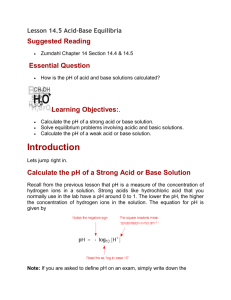
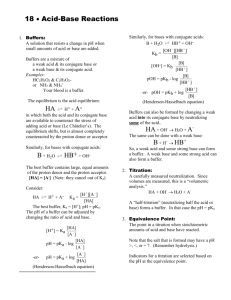
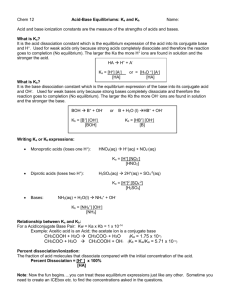
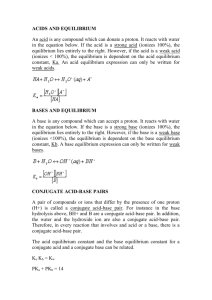
![CHEM 1520 SI MON, TUES, & WEDNES 1.Calculate [H3O+] in a](http://s3.studylib.net/store/data/007346334_1-b78d73402f58153c92290299886ff084-300x300.png)
